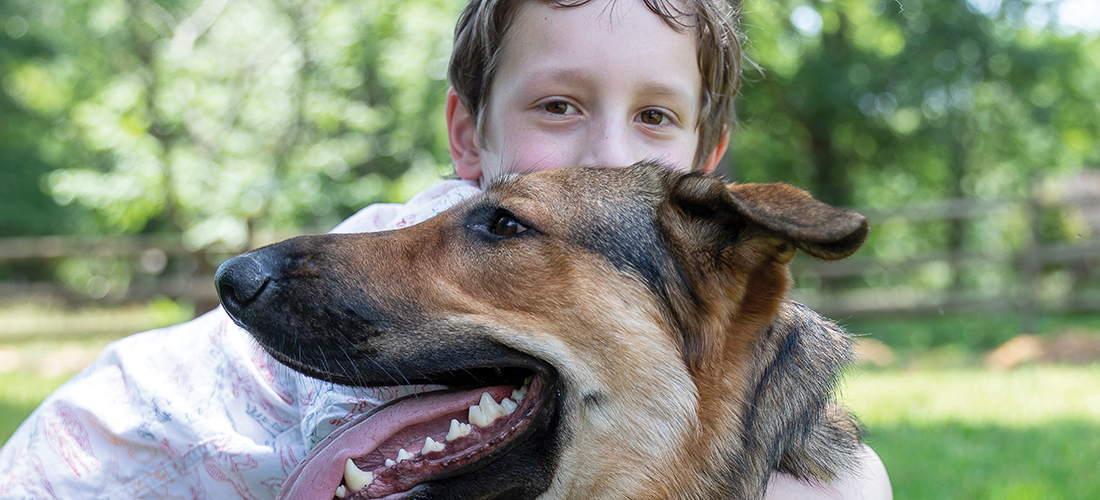
A Loving tribute to the dogs that found us
Photographs by Bert VanderVeen
Moose
Fourth time’s the charm
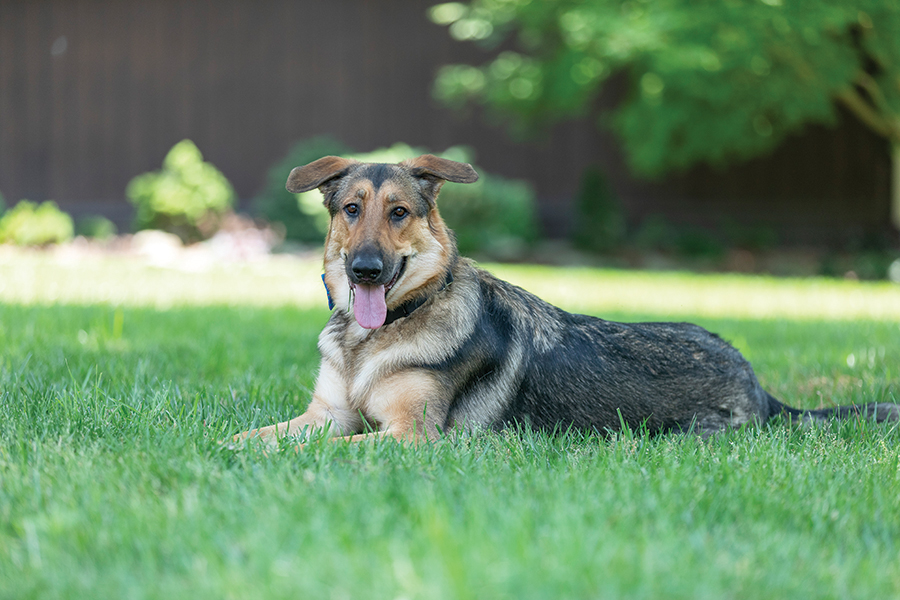
Lauren Riehle and her husband, Josh, are veterans of the animal rescue circuit. She serves as executive director of Red Dog Farm Animal Rescue Network, a remarkable organization started in 2006 by Garland and Gary Graham that has saved and placed, through its network of volunteers and foster families, more than 50 different species and 4,000 different animals, ranging from emus to cats, hedgehogs to dogs, into new homes.
Two years ago, the Riehles lost their beloved German Shepherd mix, Harley, a wonderful dog that served as a therapy dog and helped Lauren teach about animal rescue in the classroom. “We were heartbroken to lose Harley,” she says. “We absolutely adored that dog.”
They agreed to keep an eye out for another large breed dog that would get along with Penny and Gibson, a pair of highly independent Shelties the couple adopted over the years.
A year ago, Red Dog Farm’s small animal specialist, Haley Garner, phoned Lauren to say that she’d found the Riehles’ next dog — a 4-month-old male German shepherd puppy that had already had three different owners. “Naturally, my question to Haley was what was wrong with the dog?”
The short answer is nothing. The pup had been with potential owners who, for reasons ranging from work schedules to personal allergies, simply could not give the young shepherd the kind of home he deserved.
Lauren and Josh decided to take in the pooch as a foster case. “We were frankly blown away when we met him,” Lauren picks up the tale. “He was almost the spitting image of Harley and such a really sweet dog. We decided to add him to our family.”
The first thing the pup needed was a permanent name. “We sat on our back deck and considered a lot of different names. Josh, who is 6-foot-8, wanted a big-dog name, and so did our son, 7-year-old Drew.”
“The boys,” as she calls them with a laugh, settled on the name “Moose.”
Since that time, Moose has lived up to his name in numerous ways. In just one year, he weighs in at 85 pounds, growing so rapidly the couple decided to have his DNA tested to determine if he might have some Great Dane in him. The test confirmed that aptly named Moose was a pure German Shepherd — just a very large one.
“It’s uncanny how similar he is to Harley,” she reports. “He loves to run and tumble in the yard with Drew and Penny our younger Sheltie, though she makes it clear who is really in charge. Gibson, who is 15, prefers to simply ignore him — which is hard to do since he’s still growing and is really one big goofball, always ready to play.” Lauren reports that Moose has become Drew’s favorite playmate. “They love to lie together on the couch watching movies. He doesn’t grasp the whole social distancing thing,” she adds with a laugh.
Like his beloved predecessor, Moose is also very gentle and smart. Lauren envisions him possibly someday becoming an outstanding therapy dog himself.
“He seems to have the perfect personality for it — loves people and other animals. Everyone is his friend.”
Moose is living proof, she adds, that rescued animals often find their way to the place — and the people — where they were meant to be.
— Jim Dodson
Amazing Gracie
100 proof Bull
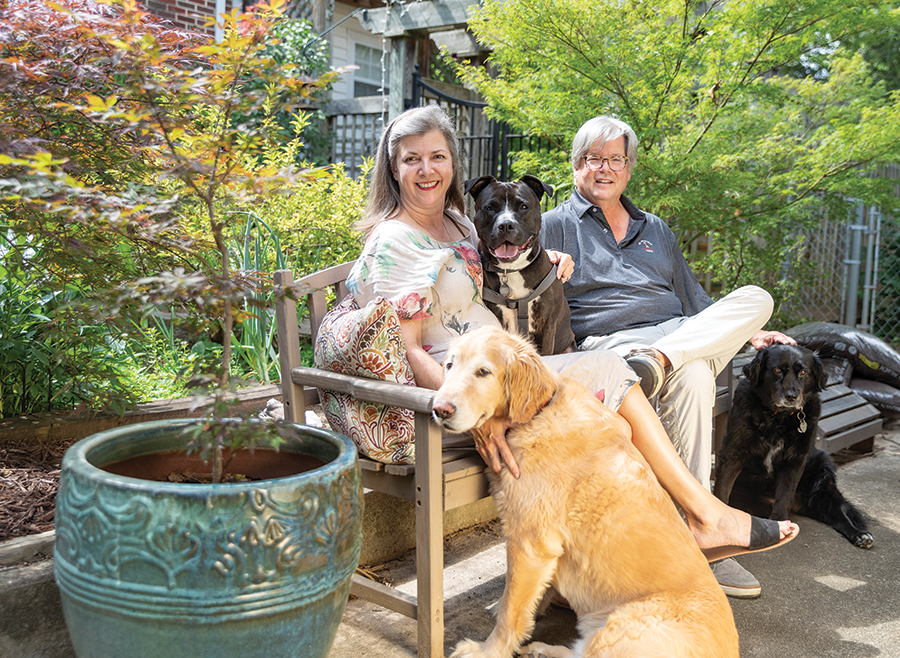
Maybe we can blame it on very good bourbon.
Two years ago this November, as my wife Wendy and I were returning by car from Chicago where we’d shared Thanksgiving with my daughter and her fiancé’s family, we decided to stop at the Buffalo Trace Distillery in Frankfort, Kentucky, to pick up some Christmas spirits and toast our expand family.
During the sampling tour, we fell into conversation about our first meeting with Walnut, a muscular brindle pit bull that Maggie and Nate rescued from a city-run animal control center in Chicago just hours before the dog was scheduled to be put down. Walnut’s previous life on the embattled streets of the Windy City’s South Side left him emotionally scarred and with few options. He had twice been adopted only to be sent back to the shelter for aggressive behavior.
As a desperate final gambit to save him, friends who worked as volunteers at the shelter — “a place full of stray street dogs nobody ever comes to see, much less adopt,” as Maggie describes it — placed Walnut’s otherworldly face online for Valentine’s Day, prompting my daughter and her squeeze to swoop in and rescue the big fellow in the nick of time. The addition of Walnut expanded their family to four, including a sweet beagle mix from Tennessee named Billie Holiday that Maggie rescued during her years in New York City.
Walnut quickly bonded with his new owners and Billie Holiday, yet his emotional issues, perhaps a form of doggie PTSD, a propensity to lose control at sharp noises and around certain kinds of people and small yappy dogs, led to a year of challenging rehabilitative work with a trainer.
“In truth, he kind of flunked out of the class,” Maggie concedes with a laugh, “because he never really learned the difference between play and aggression. But we weren’t about to give up on him. On the plus side he turned out to be very loving and responsive, a big needy child.” Their experience with Walnut seems to confirm the wisdom of top dog trainers that there’s no such thing as bad dogs, only bad owners.
In any case, as we headed for our hotel in the beautiful Kentucky hill country, my bride mused: “You know? Seeing Walnut and Billie makes me think maybe we should adopt a rescue, too.”
I reminded her that we already had two terrific dogs — a wise old gal named Mulligan (I call her “The Mull”) that I found running wild and free as a pup beside a busy highway a dozen years ago, and a sweet-tempered purebred, middle-aged golden retriever named Ajax (a.k.a. “Junior”) that I’d given Wendy for our 10th wedding anniversary. Mully was almost 13. Junior was now 8. Did we really need a third — and a rescue?
“Wouldn’t hurt to look,” she came back.
Not 40 seconds later, she showed me a photo on her iPhone. “So what do you think of this dog? Her name is Cardinal.”
I saw a chocolate-brown dog with a bright white chest, intelligent eyes and alert ears. Festively draped with colored Christmas lights, she was the shelter Dog of the Month sponsored by Lucky’s Pet Resort & Day Spa in Greensboro.
“That looks like a pit bull,” I warily pointed out.
“I know.” Wendy said. “Doesn’t she look sweet?”
Cardinal had been a resident of the Guilford County Animal Shelter for months, a refugee from the streets of south Greensboro, assumed to be roughly 2 years old, “sweet-tempered and loves to play,” read her police file, er, shelter profile. “Good with other dogs.”
Wendy gave me what I call The Look. “I think we should save her.”
And so, one week later, I drove out to Lucky’s to pick up my wife’s Christmas present, wondering what kind of challenge lay ahead. I’d spent the week reading up on pit bulls on the American Kennel Club’s website and other sources and was surprised by what I learned.
Pit bulls were created by cross-breeding traditional bulldogs and English terriers, which produced a tenacious animal used in pit fighting until the British government outlawed the sport in the mid-19th century, at which point dog-fighting went underground. In his fascinating 2006 New Yorker essay on what prejudice against pit bulls can teach us about racial profiling of both human beings and dogs, writer Malcolm Gladwell pointed out that though pit bulls have been responsible for numerous well-publicized attacks on humans in recent years, not to mention becoming the targets of civic bans, evidence is overwhelming that the breed is no more aggressive and dangerous than other large breeds — unless trained to be so.
The line that just jumped out at me from a leading expert in canine behavior: “A mean pit bull is a dog that has been turned mean, by selective breeding, by being cross-bred with a bigger, human-aggressive breed like German shepherds or Rottweilers, or by being conditioned in such a way that it begins to express hostility to human beings.”
In Britain, I also learned, pit bulls are especially prized for their gentleness with children and are often trained to be therapy dogs for their keen intelligence, devotion and responsiveness to positive human interaction. Also, not every pit bull is the same breed.
Young Cardinal turned out to be a Staffordshire bull terrier. I read up on her type, too.
“From his brawling past,” noted the breed’s American Kennel Club profile, “the muscular but agile Staffordshire bull terrier retains the traits of courage and tenacity. Happily, good breeding transformed this former gladiator into a mild, playful companion with a special feel for kids.”
That was promising. Sort of.
Then there was this from the Staffordshire Bull Terrier Club of America:
“They are tough, courageous, tenacious, stubborn, curious, people-loving and comfort-loving, protective, intelligent, active, quick, and agile . . . Staffords love to play tug-of-war and to roughhouse, but YOU must set the rules and YOU must be the boss.” SBTC goes on to say that the Staffords’ alert, muscular appearance is very striking. They look tough, and that can be a positive deterrent to thieves. But because of their natural fondness for people, most Staffords tend to protect people and not possessions. “A Staffordshire bull terrier desires, more than anything else, to be with its people.” Quoting a chapter from Steve Eltinge’s The Staffordshire Bull Terrier in America, the site concludes: “From the time he awakens in the morning until the quiet of night, a Stafford lives life to the fullest.”
Cardinal seemed worth the risk, though she did have one major issue.
Though young, she suffered from an advanced stage of heartworms that was being kept in check by monthly medication. We were warned that if we adopted the dog, she would need an expensive and lengthy treatment regime to save her life. Among other things, her movements would need to be restricted and she should not be allowed to run for months for fear of sudden cardiac arrest.
Truthfully, as I drove out to Lucky’s to sign the papers and pick her up, I was still having a little debate in my head. Did we really want to bring a damaged pit bull of unknown origin into our happy dog family? Did I mention that we also have a cranky old cat, saved as a kitten from the gentrified streets of Southern Pines? His name is Boo Radley, and he’s highly independent and not just a little pushy. How would Boo take to a pit bull? Or worse, vice versa?
The first thing we did was give her a new name. A new life warranted a new name. I lobbied for “Santa Claws” but we settled on “Gracie,” a name we hoped she would grow into.
And grow she did.
Over the next year, she put on almost 20 pounds, indicating she was much younger than believed.
After some initial tension with our two resident dogs, they quickly settled into a friendly routine with Gracie actually deferring to the household grande dame, Madame Mully, who only grows agitated and rushes in to nip the newcomer whenever she sees me rough-housing or playing tug-of-war with Gracie, her two favorite games. We took to calling Mully “The No-Fun Nun.” The funny thing is, if she wished to do so, Gracie could inflict terrible damage on the old girl. But she doesn’t. Gracie politely defers every time.
Junior, on the other hand, became Gracie’s best pal, the two of them typically sharing a couch — or their owners’ marital bed — whenever possible.
Even Boo Radley has developed a guarded affection for “The Bull,” as I often call her — especially during morning walks when she drags me around the neighborhood on her leash, striking fear only into the hearts of fleeing rabbits and squirrels dumb enough to invade our backyard. I even trained her to snap carpenter bees out of the air.
Almost everything about this once-lost dog, I must say, has proved heart-warming and amazing.
In short, she is everything a Stafford is said to be: tough, courageous, tenacious, stubborn, curious, people-loving and comfort-loving, protective, intelligent, active, quick and agile as a world-class athlete.
Thank God she doesn’t care for good Kentucky bourbon.
— Jim Dodson
Pilot
Seen in Mississippi, Herd in N.C.
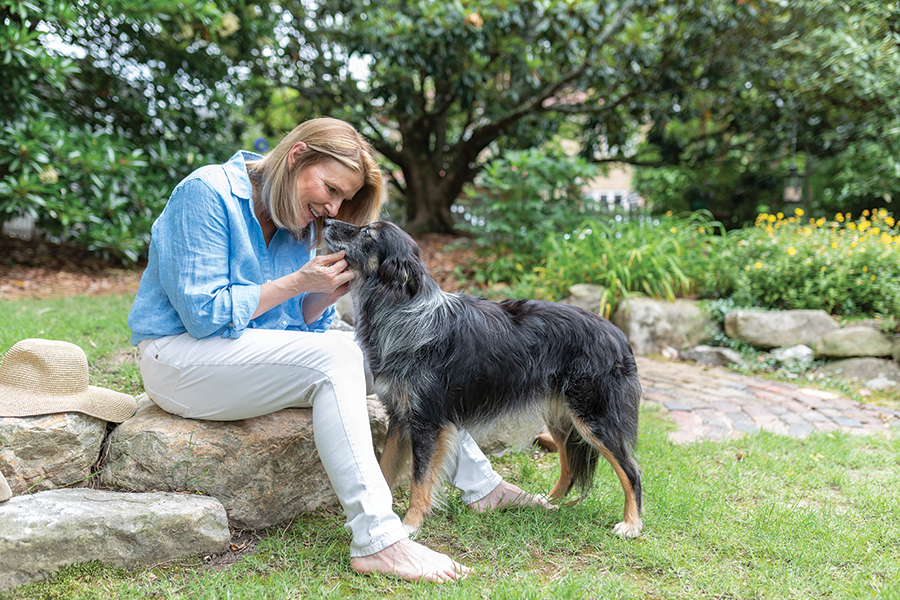
Having flown in from Greensboro, there I was at the Sonic Drive-In in Pearl, Mississippi.
“You sure came a long way,” said a guy who’d struck up a chat, “just for a dog.”
Yep! About four states and 750 miles. Suddenly I felt rather stupid about it. Just what was I doing, adopting a dog I hadn’t even met, in a place so far from home?
I was a bit lost, honestly. Three months before, I’d seen my beloved border collie, Sully, get hit by a car on Church Street. Later at the vet, I stroked him and said goodbye before he was put to sleep. Not long after, in a round of layoffs, I lost the job I’d loved for 10 years.
Now, two weeks into unemployment, here I was, tired and anxious and worried that I’d made a very foolish mistake.
It was all my friend Teresa’s fault. Several weeks after Sully died, she saw an online posting for a beautiful, 7-year-old tricolor border collie in Dallas. He was a much-loved pet, but a family situation was forcing the owner to rehome him. (And, key fact: A rescue group had volunteered to deliver the dog.)
I was intrigued. A good dog is like a good husband: Hard to find. I love border collies — herding dogs bearing an intelligence and loyalty that make them trustworthy, playful and affectionate. But with no sheep to keep them busy, I need that rare border collie blessed with a calm temperament — an “off switch,” as folks say. In short, I like a working dog whose favorite part of the day is lunch hour.
On a video the owner sent, the dog appeared smart and strikingly laid-back. His eyes, though, sealed the deal. I saw a kind, eager-to-please nature in his gaze. I’ve had collies since I was a child; this, my instinct said, was a good one.
When the rescue group’s delivery offer fell through, there I was, my heart pounding as I waited to meet my new best friend.
Now, I’ve done enough online dating to know that photos, even videos, can be deceiving. The “real thing” is often different, often a disappointment.
An SUV with Texas plates drove up, and the dog jumped out. I took one look and saw the intelligence, the graceful herder’s gait, and most of all those kind brown eyes.
I knew: I’d come a long way, and it was worth the trip.
He had a name, of course: Pilot. And in the year since he’s been my companion, my hiking buddy, my solace, my guide. When we walk, he’s always ahead of me, leading the way. And each time he cranes his neck around to make sure I’m still following, then flashes his happy grin, I know I didn’t go too far for a dog.
Life works funny sometimes. We don’t always know where we’re going and sometimes we’re surprised at where we end up. Sometimes that spot is the Sonic Drive-In in Pearl, Mississippi.
But if we’re lucky, we get a Pilot to guide us home. — Lucinda Hahn
Bundle of Joy
Christine Catania gives a new meaning
to dog-boarding
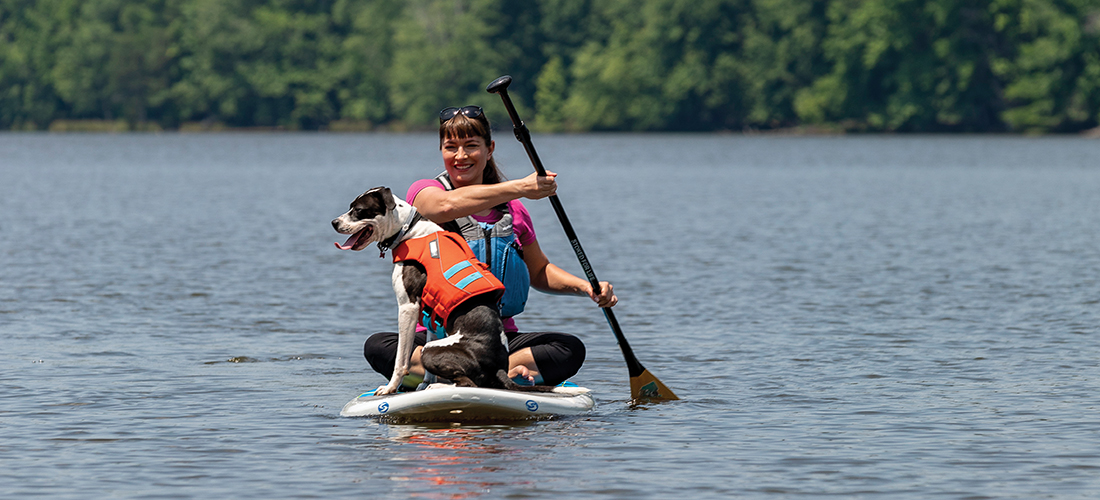
Christine Catania’s widely known as the Triad’s Ice Queen, a shortened version of her mobile business, Ice Queen Ice Cream. But she is, in fact, a softie who serves frozen treats and saves rescues.
Catania was content with her pack of two that included Moxie, an “adorable and super smart” 12-year-old mixed breed found in 2008 wandering in the snow, and Lulu, the American Staffordshire terrier/boxer/beagle “steamroller of love,” who was down on her luck when Catania adopted her through Dr. Janine Oliver and Alison Schwartz of All Pets Considered. “I never wanted three dogs, but thought I could foster a puppy,” says Catania.
Then along came Joy.
Primarily American bulldog, with a distinctive black-and-white mask, which is all-natural, and a perfect foil during a pandemic, Joy, who will be 1 year old on July 12, was born while being fostered by another family. “Her mom was at the Forsyth County Animal Shelter and was being fostered while she had her puppies. Her family fell in love and adopted her” Catania explains. Having grown up among animals in her native New Jersey (“Our childhood friends were parrots, parakeets, horses, dogs, cats, guinea pigs . . . we had a zoo!”), Catania was no stranger to fostering dogs. She regularly volunteers with Merit Pit Bull Foundation in Greensboro whose mission, she says, is one of rescue and outreach for pit bulls.
“I’ve always loved pit bulls since my sister adopted one from the shelter in New Jersey in 1998,” she recalls. “She had her throughout her life; she was an extraordinary dog.”
She has since sought rescue organizations after her move to the Gate City to study art at UNCG and began fostering some nine dogs ago, her first attempt being her most ambitious: a 130-pound Great Dane.
Learning to work with socially anxious animals and those with separation anxiety or fear aggression, Catania takes advantage of “so many resources and training online, with free websites on YouTube.” Patience is also key.
“I’m calm and patient, and take little steps,” she explains.
Not that she needed to worry about anxiety or aggression in her newest charge, who even accepts her rescue cat, Steve. “She was so perfect!” Catania recalls, her affection for Joy palpable.
At 44.9 pounds of “pure muscle,” Joy — named for Joymongers craft beer — is athletic and “also the smartest and most endearing, the most incredible puppy,” Catania says. Joy is also agile and sufficiently fearless enough to have begun mastering paddle boarding. Catania’s partner, by the way, has a standup paddle boarding business.
Catania says the dog likes to hit Lake Brandt and “jumps right on the board” kitted out in her own lifejacket. Joy even has a Facebook page dedicated to her water sporting fun: Joy, the SUP Synergy SUP PUP.
It’s a good life for the pooch and her two stepsisters, especially when Catania, a self-described “homebody,” prepares unusual flavor combinations for Ice Queen in her home time. Her treats are many and varied, but Ice Queen’s specialty are 15 varieties of handmade ice cream “sammiches” with whimsical names such as King Kong, Big Bird and Midlife Crisis — sized petite or Mac Daddy.
And for canines?
Pupsicles, of course, made of yogurt, honey and peanut butter. Catania creates them for dog-related events and has occasionally sold the treats for the benefit of animal rescue. During the pandemic she has sold human and dog treats through her web site,
www.icequeenicecream.com, and made donations of “sammiches” to front-line workers at Cone Hospital, when she wasn’t tooling to planned stops throughout the Triad in her gaily painted converted short buses, Snow Drop and Shortcake. One hopes, with warmer, humid days approaching, she’ll be able to tour randomly, selling “sammiches” to humans and keeping a supply of pupsicles on hand “to give to puppers.”
Catania doesn’t charge for these, she quips merrily, “because dogs don’t carry money.” — Cynthia Adams
A Rose by Any Name
David and Pamela McCormick’s new addition
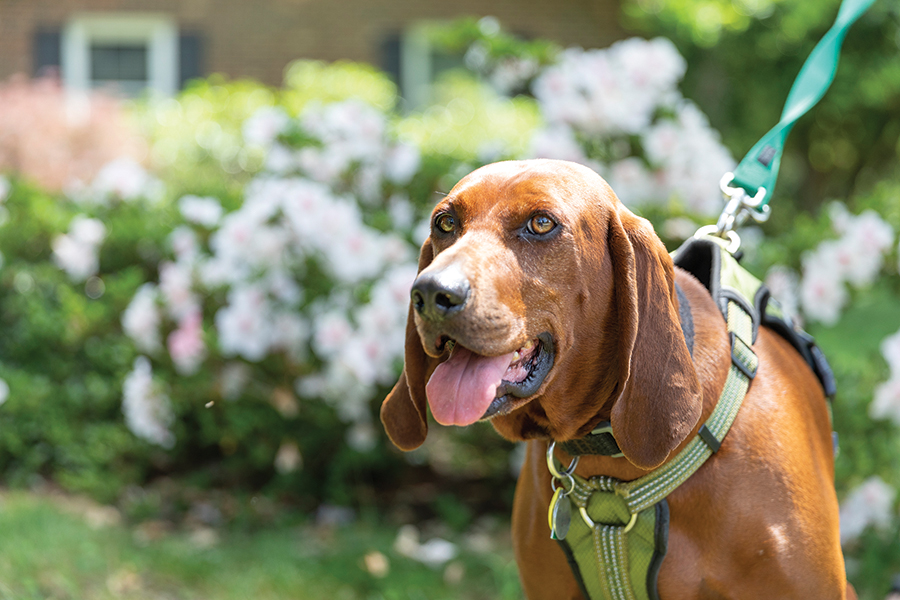
If Charles Dickens had written dog stories, the unlikely journey of a redbone coonhound named Mocha that became a Rose would make a true page-turner.
Just over 18 months ago, the young female dog wandered up to a house in southern Virginia, emaciated and pregnant. The stray was pitifully hobbling on three legs, probably the result of an unhappy run-in with a car.
The next day, the folks who took her in served as midwife for the birth of eight puppies. Through their family connections to Sedgefield Animal Hospital and Red Dog Farm Animal Rescue Network, the pups are placed in foster homes. All were soon successfully adopted.
Their sweet mama was treated at Sedgefield Animal Hospital, undergoing a procedure that removed the damaged ball and socket of her shattered hip, allowing new cartilage to form a “false” ball joint as the hip heals. The prognosis was good. In time, even her limp would fade.
As all of this was happening, David and Pamela McCormick were thinking their 12-year-old, female Cairn terrier, Coco, could use a new companion following the recent demise of their older male Cairn terrier, Charlie.
With the assistance of Alison Schwartz of All Pets Considered, the McCormicks brought home a young rescued female Dachshund only to find that the match was not a good one. “She was a little too wild for Coco’s tastes,” says David, an IT specialist who works at UNC-Chapel Hill. Wife Pamela is a schoolteacher.
A short time later, however, the McCormicks checked out the Facebook videos of Schwartz’s weekly Pet of the Week segments with Lora Songster of WMAG-99.5 radio. When they heard Schwartz describe Mocha as “about the sweetest dog imaginable,” they decided to go have a look — and found, in January of last year, the perfect rescue to adopt.
There was only one apparent problem.
“We couldn’t have a Coco and Mocha under the same roof,” says David with a laugh, “so we gave her a new name that really seemed to suit her: Rose.”
Early on, Rose was extremely shy with her new owners, however, preferring to initially stay in the large fenced backyard of the McCormicks’ house off Fleming Road. She also suffered nightmares. “Blood-curdling screams two or three times a night. We would sit down and hold her,” David provides. “It probably took six months to get over those.”
The McCormicks’ patience eventually paid dividends. As Rose’s hip healed, the nightmares ceased. “It’s funny,” he adds, “It’s almost as if one day she woke up and realized she was where she really belonged. Ever since then she has been a joy in our family; even Coco, who had no interest in another dog, accepts her. She’s a big goof, actually, loves to run and play, sometimes spins crazy circles. She howls with pleasure for her supper. And every day she wakes up delighted to see us — even if we’re away only a few minutes.”
The McCormicks report that Rose adores her daily 2-mile walk around the neighborhood. “The transformation has been amazing to see,” adds David. “She is healthy and full of energy and really one of us now.” — Jim Dodson
Abiding with Bella
Paw de deux
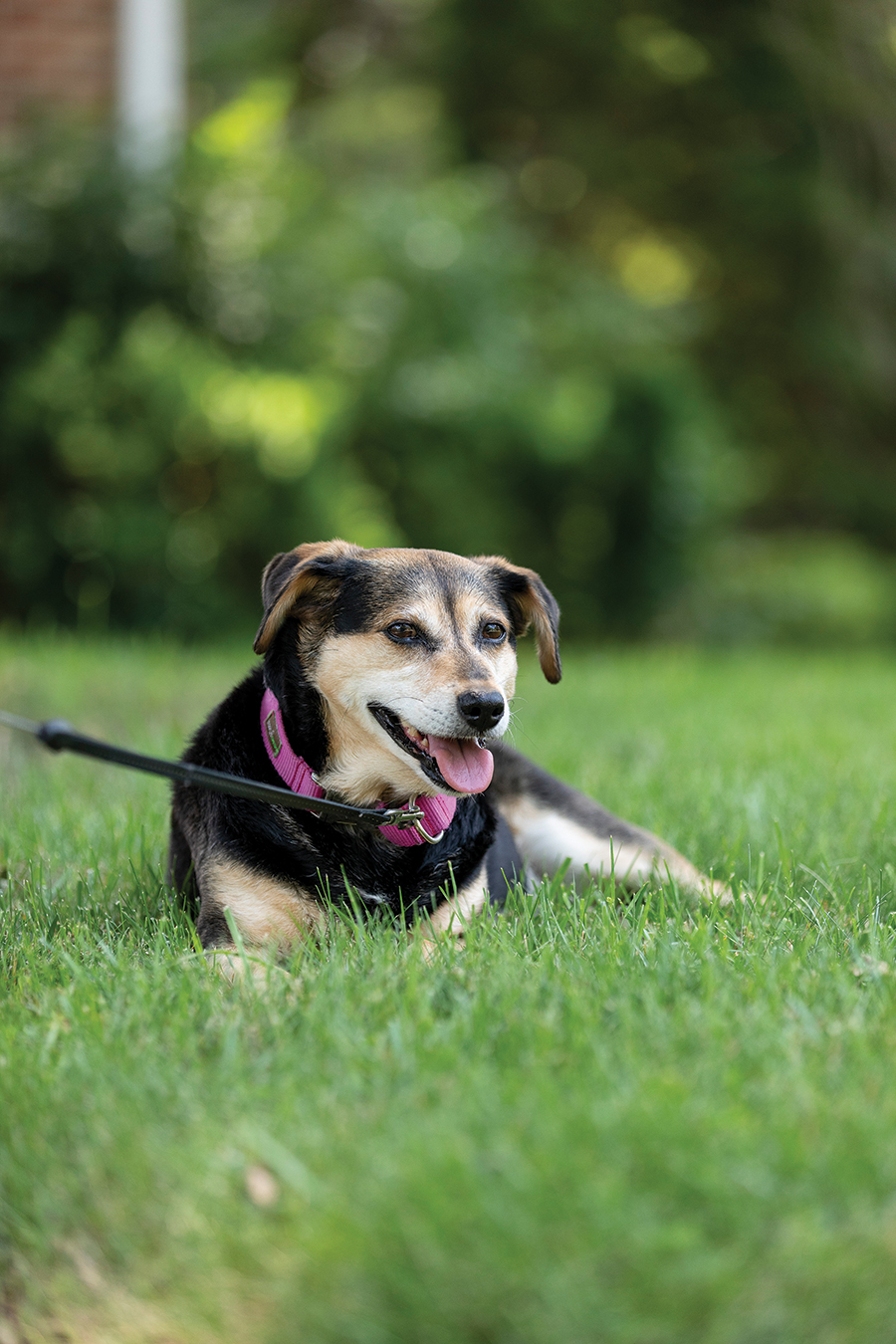
Mary Cole has always been an inveterate walker. “It’s what I enjoy,” she says. Growing up in Leicester in the Midlands region of England, she was accustomed to taking “long walks and treks” by herself. In those days, she kept a cat around the house for companionship, but it wasn’t until her late husband, Trevor, presented her with a golden retriever as a wedding present that dogs became central to Mary’s life. “I’m a shy person,” says the self-professed loner and animal-lover. “Give me a good book and I’m happy. Give me a drink and you don’t know what’s going to come out of my mouth!” she quips. “But I love my own company — me and me. Me and me get on just fine — and Bella, of course. She thinks I’m wonderful.”
Thanks to Bella, a tail-less, 8-year-old dachshund/beagle mix with perhaps a touch of terrier, Mary never walks alone. The two often stroll through the green expanse of Guilford Hills Park and its suburban environs, and before the pandemic struck, along the wooded trails of Military Park. Its closure, along with the local libraries’, was “a great sadness” to Mary, who would often drive by the closed gates hoping to find them open again. In the interim, Country Park would have to do. “I walk Bella a lot, Mary explains. As in, three times a day. “We both like to eat,” she adds. “I can’t imagine what we’d look like if we didn’t!”
Mary and her current husband, Ervin, whom she met while working as a receptionist at PBM Graphics (“because of my accent,” she jokes. “Open my mouth. Get a job.”) adopted Bella four years ago through Thomasville’s Ruff Love Rescue. Then called Esther, owing to a star-shaped marking on her chest (“I can’t imagine calling her Esther!” exclaims Mary), they had noticed the dog, as well as a whippet on the organization’s web page. At the arranged meeting in High Point, Ruff Love’s representatives introduced three dogs, Bella being the last. “She came trotting in and sat between Ervin’s legs. So we said, ‘Well, that’s it, then,’” Mary recalls. A bonus was the fact that Ruff Love would return the adoption fee after two weeks, should dog and owners be incompatible.
But that’s hardly the case with Bella, “a very mannerly girl,” as Mary describes her genial sidekick, though she’s cautious around other dogs during their turns around the neighborhood (and, of course, the Coles’ other rescue, a feral cat named Nala). “People approach you and say, ‘My dog’s friendly.’ Oh? Good for you. Mine’s not,” Mary says, explaining that Bella has been known to “rear up” around aggressive canines, especially if they’re unleashed.
Ervin sometimes ribs Mary about her lax dog training, especially while she’s watching reruns of Cesar Millan’s Dog Whisperer. Mary’s retort: “We’re happy as we are. We don’t want to be too good. Good people are boring. Good dogs are boring as well.” — Nancy Oakley
Baxter
A port in the storm
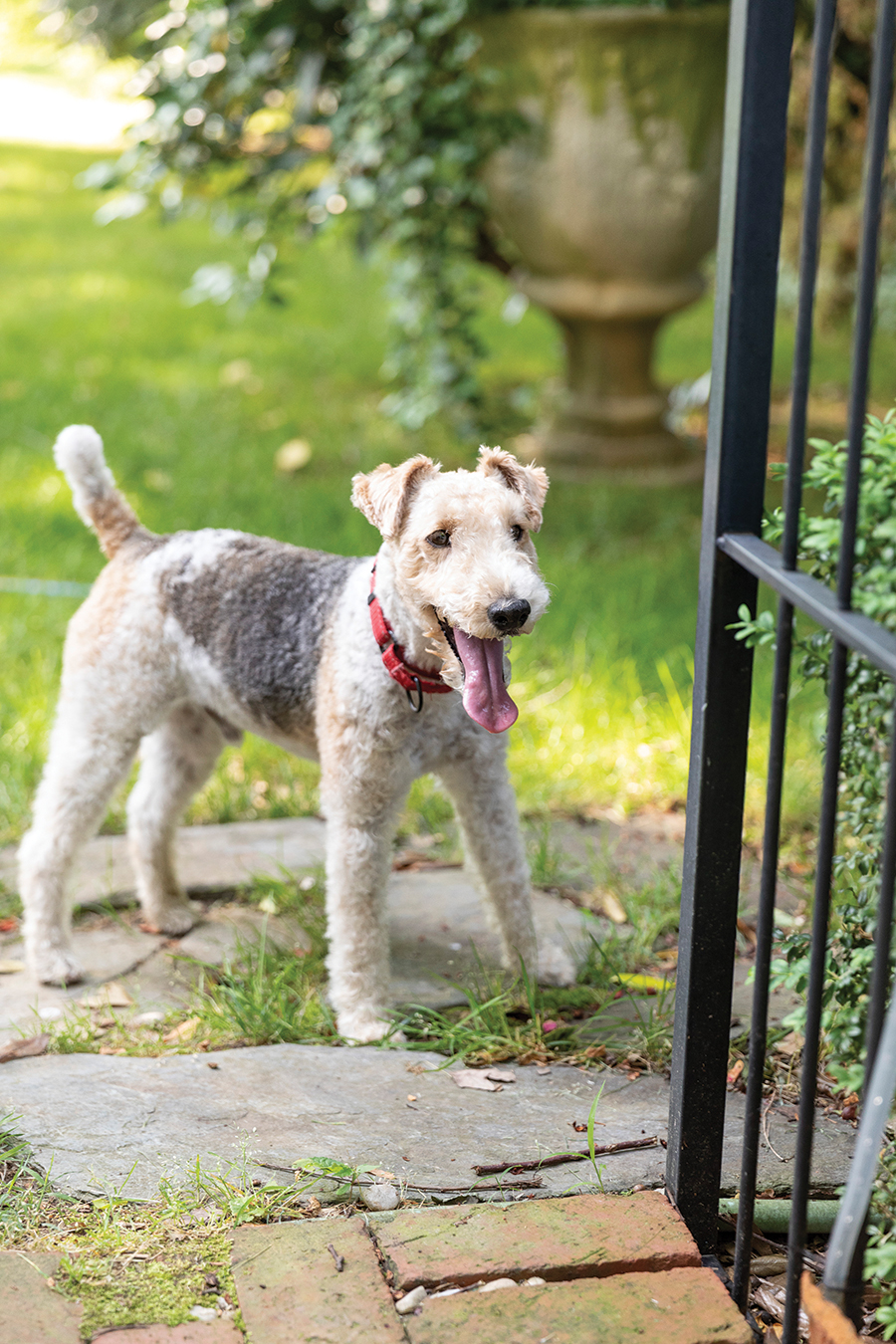
We were in Lowe’s in Southport, as our condo seems ill-fated with storms frequently hitting the tiny town, requiring us to make constant repairs.
Our dog Patch has been going on these hardware store forays and anticipates the treats from Lowe’s staffers.
He was in the cart, munching happily on a dog biscuit, when I felt a tap on the shoulder.
“Is that a wirehaired fox terrier?” a young woman asked. I explained that Patch was a Schnauzer, though liver-colored. You might mistake him for an overgrown hamster. He appeared in O.Henry two years ago when he was a mere pup.
The young woman, Melissa, had several boisterous, chatty red-haired children hanging off her cart. Small hands grabbed for Patch. She told me they, too, had a terrier. Then, her face crumpled. Hers had to stay out in the yard because he sometimes snapped at the children.
“We won’t be able to keep Baxter,” she said sadly. “We want a situation for him like your dog’s.”
I digested this. “You mean, you want to place him?”
“Yes,” Melissa said. “Baxter’s been living outside the last four years. He’s 5.”
I asked for contact info and pictures, explaining we had sometimes helped place dogs.
“Maybe you’ll want to try keeping him inside again?”
She shook her head doubtfully.
My husband had been investigating wirehaired terriers. This seemed providential.
That same night, lightning flashed and rain lashed as thunder reverberated. I thought of a little terrier relegated to endure it alone. Sleep was fitful.
We reluctantly returned home the next morning, knowing Baxter deserved help.
Was I insane? There was no calm in the inner storm of our family life. Work was intense; more important, my mother was dying.
In a few days, messages arrived with a picture of Baxter, appearing too thin and in need of a bath. But he was a beautiful animal.
We exchanged texts. She had him groomed, and when I saw the picture of the little guy all spiffed up, my heart sank further. How could she possibly give him up?
I assured Melissa we would help place him, urging her not to surrender him before we could return. I asked friends if they might be interested in adopting Baxter. No dice.
Meanwhile, my mother was worsening.
While I was with her, my husband, Don, drove back to Southport to pick up Baxter but was conflicted. “What if this dog is a problem?”
Of course, he has problems, I thought privately.
Days later, Don had a list of offenses: Baxter was having accidents in the house. He was aggressive over toys.
Would he harm easygoing Patch?
We arranged to have Baxter neutered. Diana Singleton, a trainer, met with us to evaluate him.
“Don’t leave the two alone for six weeks,” she advised, looking at Patch. “You need to be sure this dog can be trusted.”
Don was grim about Baxter’s potential. “He’s a jerk,” he pronounced. “He growls at me. Offers to bite me. He chews up all of Patch’s balls. Takes every single stuffed animal outside. He doesn’t obey.”
What I saw was a dog who had been shoved outside to fend for himself. He feared everything: even a gentle rain caused him to scuttle back through the dog door. Baxter, like me, was overwhelmed. When I hugged him, he stiffened, offering a low, ominous growl, and I fought back tears of frustration.
My mother died within weeks. Baxter had to have absorbed that tumult, possessing exquisite animal sensitivity.
As I see it, Baxter and I are both in recovery.
Seven months on, Baxter is slowly relaxing. He’s eating, walking and playing with more abandon. His limbs are looser. He offers me occasional licks on the ankle before shyly looking away.
“He’s smart,” says Don. “And is settling down really well as his tension lessens and he understands us. And, we are learning to understand him. He’s a vocal dog, not an angry dog. He loves to lick and chew and hang on to his toys. But,” my husband concedes, “He does not bite. I misread him as a biter.”
He acts more and more like a dog who belongs to someone.
He belongs to us.
And we are going to be OK.
– Cindy Adams





